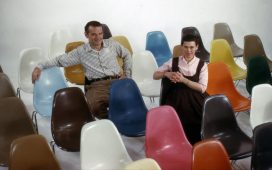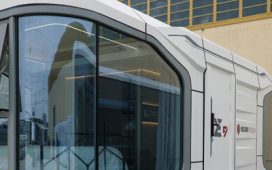Like many neighborhoods in postindustrial cities, Detroit’s Core City has seen its share of difficult times. But for almost a decade, developers and investors have flocked to the four-square-mile area, buying up city-owned properties to create place-sensitive housing. The Canopy, a multifamily development designed by Los Angeles–based firm EC3, is one of the most recent additions to the neighborhood’s real estate boom. Highlighting site conditions and borrowing from nearby architectural landmarks, the 10 new housing units depart from the slick design tropes of broad-scale “gentrification” in favor of a quiet nod to existing community fabric.
Edwin Chan, architect and founder of EC3, has been working in Detroit for almost a decade. He was initially brought to the city in 2016 to visit Philip Kafka, founder of development firm Prince Concepts, which focuses primarily on Core City, after being introduced earlier in Los Angeles. After his visit, Chan decided to accept an invitation from Kafka to design a new housing development that became True North. On a formerly vacant 25,000-square-foot site are now eight freestanding buildings in the style of Quonset huts; the development includes seven live/work rental units, a yoga studio, and a short-term rental. True North was received with much acclaim when it was completed in 2017, winning or listing several design awards; However, Detroit Development News, a Substack publication that covers timely changes to the city’s built environment, claims that while Kafka has done some amazing work, he “also has his own philosophies and way of doing things that sometimes draw a side eye from some residents. The Quonset huts were new and interesting, but they certainly don’t blend in with the architecture of the area.”
When Prince returned to EC3 with the opportunity to design another multifamily development in 2020, it was a chance to show how disinvestment has yielded a flourishing landscape—overgrown trees and plentiful native plants—that had the potential to become social space. He took inspiration from the 186-unit Lafayette Park townhomes designed by Mies van der Rohe, where Kafka lives. Notably, Chan was drawn to the building’s transparency—glazing known by Mies fans—that, he says, would filter light through surrounding trees and provide sight lines to the shared courtyard. “When you’re making dinner in the units, from the kitchen through the living room, you have an interaction with the public landscape next door,” Chan explains, “and you have this interesting relationship with your neighbors, and it creates a social context.”
In designing The Canopy, Chan wanted to center the landscape to build a social context but also avoid the double-loaded corridor common to many new multifamily developments; the scheme provides only one exposed wall, limiting views and light. “As opposed to building the corridor, we thought that the units should be connected through this outdoor green space,” says Chan. They separated the rental development into duplexes with two units per structure, including five studios, four one-bedroom, and one two-bedroom apartments. The site hosts a myriad of existing trees that Chan wanted to keep, and he oriented each building to ensure that windows would look out onto the courtyard, which was landscaped with native plants and flagstone walkways.
Each building includes generous windows and balconies that face inward toward this outdoor hallway and public spaces. The Canopy might take its cues from Lafayette Park’s connection to nature, but, like the homes at True North, they break from the typical Miesian grid. For both projects, buildings are arranged outside of typical tracked homes, with some sitting horizontally, and another structure oriented diagonally toward the lot’s corner. At The Canopy, situating the five buildings in relation to the existing trees meant adding some balconies and entryways at an angle to maximize exposure and access to the public space.
Keeping to the industrial landscape, Chan chose roughed stucco for the facades; a handful are painted with vibrant reds and greens. It’s certainly not the usual “pops of color” deployed across the typical “fast casual” new rental developments that use aluminum paneling, and, Chan says, it honors the postindustrial vibe: “By making the stucco rough, it kind of creates that rawness that colors the landscape, and it becomes a backdrop for the plants and the landscape.” These materials are also cost-effective: On the interiors, they chose to create partitions, built-in furniture, and kitchen cabinetry using plywood. While there is an economic discipline at play, the units are comparably less affordable—though still below the national average; 550-square foot studio units at The Canopy rent for $1,550, compared to the city’s $1,213 average rent, according to Zillow.
“What other developers with a limited budget do is they make the plans really mundane, but they try to dress it up with frivolous things; they put some decorative elements on the outside just to pretend they’re adding value, whereas, in fact, they’re not adding value,” Chan says. “We’re transforming very basic materials in an interesting way, and we try to make the floor plans very unique because they don’t have any corridors, and we want at least two to three walls that are open to the outside. You get views, you get light, you get fresh air.” Those, he says, are the luxuries.
Top photo by Chris Miele














